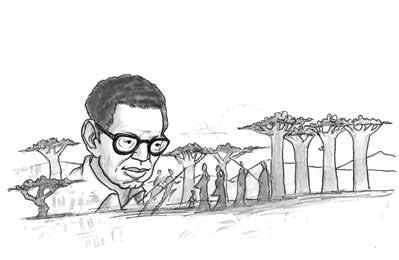

Robert Earl Hayden A Man, a Pencil, and Poetry for All People
by Susan Engle
illustrated by Luthando Mazibuko
Bellwood Press
1233 Central St., Evanston, IL 60202
Copyright © 2025 by the National Spiritual Assembly of the Bahá’ís of the United States
All rights reserved. Published 2025
Printed in the United States of America ∞
28 27 26 25 1 2 3 4
ISBN: 978-1-61851-274-1
Cover and book design by Patrick Falso
Illustrations by Luthando Mazibuko
9 / Triumph in Senegal, Troubles at Fisk
10 / Back to Michigan, to Washington, DC, and Finally . . . Fame! .........
11 / “This man, superb in love and logic
1 / An Interesting Family
Some of the first words a baby learns are the words of his or her name. This baby was named Asa Bundy Sheffey. “Asa Sheffey” was his birth father’s name, and “Bundy” belonged to the doctor who delivered him. Odd that the doctor’s name was chosen at all, because the baby’s eyes were accidentally damaged by Dr. Bundy at birth. Odder still, the boy wouldn’t find out about this name until he was a grown man. As far back as he could remember, he had been called Robert Earl Hayden.8
Robert’s mother, Gladys Finn, had more than one name, too. She must not have liked it for some reason, because she changed her name to Ruth when she ran away from home to join a circus as a teenager. She was quite beautiful, and she knew she wanted to be a performer. When she married Robert’s father, a coalminer from West Virginia, her name became Ruth Sheffey. They weren’t married for long. By the time Ruth gave birth to Asa on August 4, 1913, in Detroit, Michigan, she and the baby’s father were divorced.9
Perhaps, being on her own, she discovered that becoming a mother was
nothing like the life on the stage that she pictured for herself. She turned to friends of hers, William and Sue Ellen Hayden, for help. They agreed to take care of the baby while Ruth moved to Buffalo, New York, to find work that she loved and that would help support her child.10 Though Ruth came back to visit, and even lived with the Hayden family for a time when the baby grew to be a teenager, William and Sue Ellen raised Robert as their own. For most of his life, Robert thought he had been adopted by the Haydens, but money was tight and adoption was expensive.11 Although the arrangement Ruth
Hanson would post them on a board in the poetry section of the library as a small celebration of his talent.31 In these high school years, he first began to show his ability to earn honors in writing when he won an award for a short story called “Gold.”32
After his graduation from high school, Robert submitted a poem that was published in a 1931 edition of Abbott’s Monthly. This magazine was written especially for African-American readers and was founded by Robert Sengestacke Abbott, whose original publication, the Chicago Defender, was one of the most widely read newspapers of its kind in the United States.33 Robert’s
poem was called “Africa.” One stanza, which describes his feelings of oneness with the continent that was once his ancestors’ home, reads:
Though Freedom’s light upon me shines, My heart is native; my soul pines
For sight of thee, and all day long
I mourn and sing my fitful song: “Dear Africa, you’re more to me Than reeking jungle—ebon sea!
In thee I take undying pride— Dark cradle of a race denied!”34
“Africa” was modeled after a poem called “Heritage,” written by Countee

Cullen, who often wrote about racial issues in his poetry. Cullen, however, wanted to be considered simply a poet, rather than a “Negro poet.”35 Robert adopted this attitude for himself and began to hope that he would reach more and more people in time.36 For now, he had made a beginning. During his last year at Northern High School in Detroit, the Great Depression hit the United States. Life was hard
